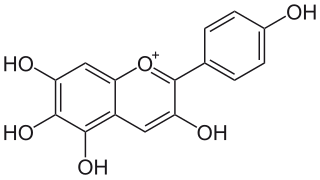This page is based on this
Wikipedia article Text is available under the
CC BY-SA 4.0 license; additional terms may apply.
Images, videos and audio are available under their respective licenses.

Anthocyanidins are common plant pigments. They are the sugar-free counterparts of anthocyanins based on the flavylium ion or 2-phenylchromenylium, which is a type of oxonium ion. They form a large group of polymethine dye. In particular anthocyanidins are salt derivatives of the 2-phenylchromenylium cation, also known as flavylium cation. As shown in the figure below, the phenyl group at the 2-position can carry different substituents. The counterion of the flavylium cation is mostly chloride. With this positive charge, the anthocyanidins differ from other flavonoids.
31 monomeric anthocyanidins have been properly identified, most of the anthocyanins are based on cyanidin (30%), delphinidin (22%), and pelargonidin (18%), respectively. Altogether 20% of the anthocyanins are based on the three common anthocyanidins that are methylated. Around 3, 3, and 2% of the anthocyanins or anthocyanidins are labeled as 3-desoxyanthocyanidins, rare methylatedanthocyanidins, and 6-hydroxyanthocyanidins, respectively.

Peonidin is an O-methylated anthocyanidin derived from Cyanidin, and a primary plant pigment. Peonidin gives purplish-red hues to flowers such as the peony, from which it takes its name, and roses. It is also present in some blue flowers, such as the morning glory.
In enzymology, an anthocyanin 5-aromatic acyltransferase is an enzyme that catalyzes the chemical reaction
In enzymology, an anthocyanin 6"-O-malonyltransferase is an enzyme that catalyzes the chemical reaction
In enzymology, an anthocyanidin 3-O-glucosyltransferase is an enzyme that catalyzes the chemical reaction

Rosinidin is an O-methylated anthocyanidin derived from Cyanidin. It is a pigment found in the flowers of Catharanthus roseus and, in lower concentration, in Primula rosea.

Aurantinidin is a water-soluble, red plant dye. It is a member of the class of compounds known as anthocyanidins and is a hydroxy derivative of pelargonidin. Aurantinidin has been reported to occur in Impatiens aurantiaca (Balsaminaceae), and also in cultivars from genus Alstroemeria.
The molecular formula C16H13O7 (or C16H13O7+, molar mass : 317.27 g/mol, exact mass : 317.066127317) or C16H13ClO7 (exact mass : 352.03498) may refer to :
The chemical formula C15H11O6 (C15H11O6+, molar mass : 287.24 g/mol, exact mass : 287.0555626) may refer to :
The molecular formula C15H11O5 (or C15H11O5+, molar mass : 271.24 g/mol, exact mass 271.060648) may refer to :
The chemical formula C17H15O7 (or C17H15O7+, molar mass : 331.2968 g/mol, exact mass :331.081778) may refer to :
The chemical compound C15H11O4 (or C15H11O4+, molar mass : 255.24 g/mol, exact mass : 255.065734) may refer to :

Capensinidin (Cp) is an O-methylated anthocyanidin. It is a water-soluble, blue-red plant dye. It is a 5-methoxy analog of malvidin, has been obtained from Plumbago capensis.
The molecular formula C18H17O7 (or C18H17O7+, molar mass : 345.32 g/mol, exact mass : 345.097428) may refer to :

Guibourtinidin is an anthocyanidin.

Hirsutidin is an O-methylated anthocyanidin, a chemical compound belonging to the anthocyanins. It can be found in Catharanthus roseus where it is the prominent compound in petals and can also be found in callus cultures.

Leucoanthocyanidin (flavan-3,4-diols) are colorless chemical compounds related to anthocyanidins and anthocyanins. Leucoanthocyanins can be found in Anadenanthera peregrina and in several species of Nepenthes including N. burbidgeae, N. muluensis, N. rajah, N. tentaculata, and N. × alisaputrana.

Pulchellidin (Pl) is an O-methylated anthocyanidin. It is a blue-red plant pigment. It can be found in Plumbago pulchella.
White flower colour is related to the absence or reduction of the anthocyanidin content. Unlike other colors, white colour is not induced by pigments. Several white plant tissues are principally equipped with the complete machinery for anthocyanin biosynthesis including the expression of regulatory genes. Nevertheless, they are unable to accumulate red or blue pigments, for example Dahlia ´Seattle´ petals showing a white tip. Several studies have revealed a further reduction of the anthocyanidin to colorless epicatechin by the enzyme anthocyanidin reductase (ANR).










